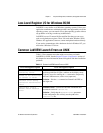
Chapter 1 Required Configuration, Installation, and Upgrade Information
©
National Instruments Corporation 1-13 LabVIEW 5.1 Addendum
Low-Level Register I/O for Windows 95/98
LabVIEW is very similar on all Windows operating systems. Unless your
application communicates with hardware that is not supported by one of the
operating systems, you can transfer VIs to other operating systems without
any problems or having to make any modifications.
LabVIEW has two VIs named In Port and Out Port that you can use to
read or write hardware registers. These VIs work under Windows 95/98.
Windows NT applications, however, cannot manipulate hardware directly.
If you need to communicate with a hardware device in Windows NT, you
must write a Windows NT driver.
Common LabVIEW Launch Errors on UNIX
Table 1-2 lists common errors that might occur when you launch
LabVIEW for UNIX. See the Required System Configuration section of
this chapter for more information about solving these and other installation
problems.
Table 1-2.
Common LabVIEW Launch Errors on UNIX
Error Message/Description Error Message/Description
Xlib: connection to :0.0
refused by server
Probable Cause—Trying to run LabVIEW as a user who does
not have permission to open a window on the display server.
Typically seen after running the
su command to temporarily
become a different user, such as root (superuser).
Solution—Exit the
su command and launch LabVIEW as
the login user.
Client is not authorized
to connect to server
Internal error during
connection authorization
check
“Executable version
doesn’t match resource
file”
Probable Cause—Version of LabVIEW executable does
not match version of
labview.rsc.
Solution—Verify that the
appResFilePath parameter
in the configuration file correctly sets the path to the
labview.rsc file.


















